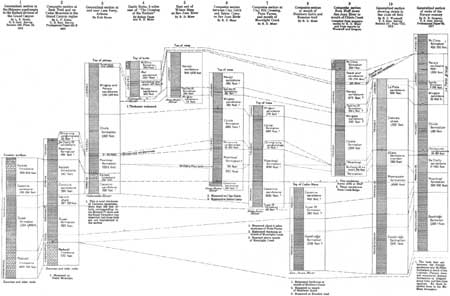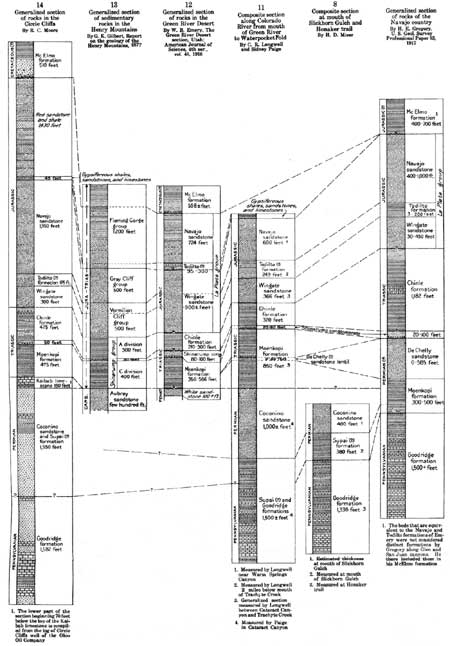
|
Geological Survey Professional Paper 132—A
Rock Formations in the Colorado Plateau of Southeastern Utah and Northern Arizona |
SEDIMENTARY ROCKS.
GENERAL FEATURES.
The nakedness of the surface rocks and their deep dissection give an excellent opportunity for detailed study, and when the entire region has been systematically surveyed there should be few important problems of correlation left unsolved. But in spite of the apparent simplicity of the geology it is not safe to attempt correlation of widely separated sections without knowledge of the intervening areas, however thorough the study of the sections may have been. Errors have already resulted from such attempts, and a certain degree of confusion now exists as to the exact stratigraphic succession and the proper terminology. Many of the formations are of continental origin, and some have yielded no determinable fossils. Certain of these formations have lithologic characteristics that are remarkably persistent over wide areas; but in many sections two or more formations are strikingly similar in general appearance, and members that are of only local distribution may be confused with formations that are considered the most trustworthy as guides to correlation. In correlating these deceptive formations, therefore, it is desirable to measure sections as close together as possible, and continuous tracing in the field is the most satisfactory method. The rocks are essentially horizontal or dip gently, except for local strong flexures, and the present writers found it possible to follow certain guide horizons essentially without interruption.
The rocks range in age from Pennsylvanian to Tertiary, but the Tertiary formations were not studied in detail. Triassic and Jurassic rocks are the most widely distributed formations on the surface, and they are largely of continental origin. Bright colors prevail, making the region a "painted desert" of great scenic interest. In Utah the older formations are revealed in a few broad anticlines, notably in Cataract Canyon and in the San Juan oil field; and in the adjoining part of Arizona they appear in Marble Canyon.
Besides the laccoliths of igneous rocks in the Henry Mountains there are a few igneous dikes and volcanic necks at other places in the part of the Colorado Plateau under discussion. In the High Plateaus, west of the Henry Mountains, there are large areas of extrusive igneous rocks. None of these igneous rocks are here described.
The section exposed in the wails of the Grand Canyon, which adjoins Marble Canyon, is probably better known than any other in the Colorado Plateau, and it is taken as a standard in correlating Paleozoic formations in the region. This section has been studied in great detail by L. F. Noble, and he has recently proposed some changes in the stratigraphic subdivision and the terminology to be used.13 (See Fig. 1 and P1. I.) His usage is indicated below, in comparison with the older usage, with a view to making clearer the discussion of Paleozoic formations here presented.
13Noble, L. F., in Schuchert, Charles, On the Carboniferous of the Grand Canyon of Arizona: Am. Jour. Sci., 4th ser., vol. 45, pp. 347-362, 1918. Noble, L. F., Paleozoic formations of the Grand Canyon at the Bass trail: U. S. Geol. Survey Prof. Paper 131, pp. 23-73, 1922.
| Older usage. | Noble's usage. | ||
| Kaibab limestone | Kaibab limestone | (Permian). | |
| Coconino sandstone | Coconino sandstone | ||
| Supai formation | Upper | Hermit shale | |
| Unconformity. | |||
| Lower | Supai formation (Pennsylvanian and Permian?) | ||
| Redwall limestone | Upper | ||
| Unconformity (?). | |||
| Lower | Redwall limestone (Mississippian). | ||
| Unconformity. | Unconformity. | ||
| Pre-Carboniferous formations. | Pre-Carboniferous formations. | ||
In thus redefining the Supai and Redwall formations Noble has definitely referred the Hermit shale to the Permian on the basis of plant remains first discovered by Schuchert and identified by David White. No fossils have been found in the thick red sandstone at the top of the Supai formation as redefined, and this member may therefore belong either in the Permian or in the Pennsylvanian.
The rock formations studied in southeastern Utah and the adjoining part of Arizona are indicated in the following table:
Rock formations in southeastern Utah and the adjoining part of Arizona.
| Age. | Formation. | Character | Thickness (feet). |
Remarks. |
| Tertiary (Eocene). | Wasatch (?) formation. | Calcareous sandstone, shale, and limestone; pink, white, and varicolored, evenly stratified, soft; composes highest plateaus; crops out in cliffs and forms slopes. | 2,000 | |
| Unconformity | ||||
| Upper Cretaceous |
Masuk sandstone. | Yellowish-gray massive sandstone with some sandy shale; grades without break into formation below; a prominent cliff-forming division. | 300-500 | |
| "Masuk shale." | Gray to drab sandy shale containing some thin beds of yellow sandstone. | 500-1,000+ | ||
| Blue Gate sandstone. | Yellow to brown irregularly bedded medium to massive sandstone; contains lignite beds up to 4 feet in thickness; forms prominent escarpments. | 230-1,000 | ||
| "Blue Gate shale." | Bluish-drab argillaceous to sandy shale; very uniform in color and texture; forms slopes and badlands; thickness, 1,100-1,200 feet. | 2,115-2,250 | ||
| Tununk sandstone. | Yellowish medium to massive irregularly bedded sandstone; contains lignite; forms escarpments and hogbacks; thickness, 60-100 feet. | |||
| "Tununk shale." | Bluish-drab sandy shale grading to fossiliferous sandstone at base; shale contains abundant Gryphaea newberryi and other fossils; thickness, 900-1,000 feet. | |||
| Dakota (?) sandstone. | Yellow to nearly white sandstone; conglomeratic in part; irregularly bedded; contains lignite locally. | 0-100 | ||
| Unconformity | ||||
| Cretaceous (?) (Lower Cretaceous ?). |
McElmo formation. | Maroon to light bluish-gray sandy banded shale; conglomerate; and coarse gritty maroon, yellow, and gray irregularly bedded sandstone; forms escarpments. | 125-565 | |
| Unconformity | ||||
| Jurassic | Varicolored sandstones and shales. | Very massive soft light creamy-white, tan, and orange-brown cross-bedded sandstone; grades into very sandy shale; weathers readily in rounded slopes and forms abundant dune sand. | 170-1,430 | Navajo sandstone of Emery. Included by Lup ton in McElmo formation. |
| Gypsiferous shales and sandstones. | Pink to red and bluish sandy shale, gypsum in beds up to 5 feet thick,
and massive white sandstone; forms badlands; 50-300 feet. Shale, sandstone, and siliceous dark-maroon and light bluish-green limestone; forms distinct escarpment; 30-55 feet. |
45-450 | Todilto (?) formation of Emery. Horizon of marine Jurassic. Included in McElmo formation by Lupton. | |
| Navajo sandstone. | Light creamy-yellow, white, pinkish, and buff, highly cross-bedded, very massive calcareous sandstone; weathers in high cliffs and innumerable cones, towers, and domes; forms caves, alcoves, and natural bridges. | 500-1,800 | Gregory's usage. Included in Wingate sandstone by Emery. | |
| Todilto (?) formation. | Maroon coarse-grained cross-bedded sandstone; conglomerate; blue-gray hard dense limestone; maroon and brown shale. All in thin irregular beds. | 125-249 | Gregory's usage. Included in Wingate sandstone by Emery. | |
| Wingate sandstone. | Reddish-brown very massive sandstone; prominently jointed; outcropping commonly in a single vertical cliff resembling a palisade. Cross-bedded but not so prominently as Navajo sandstone. | 250-500 | Gregory's usage. Included in Wingate sandstone by Emery. | |
| Unconformity | ||||
| Upper Triassic. | Chinle formation. | Thick variegated calcareous shales or "marls," fine-grained sandstones, cherty limestones, and conglomeratic limestone. Sandstone most abundant near top of formation. | 300-1,000 | |
| Upper (?) Triassic. | Shinarump conglomerate. | Light-gray to yellow coarse-grained to conglomeratic sandstone, very irregularly bedded and variable in thickness; grades locally into bluish sandy shale; contains silicified wood; forms prominent bench in topography. | 0-220 | |
| Unconformity | ||||
| Lower Triassic. | Moenkopi formation. | Chocolate-brown to yellowish shale and sandstone, containing locally in upper portion very thin hard limestones. The shale very sandy and grading into shaly sandstones; the sandstone ranging from thin-bedded platy to thick massive beds. Ripple-marked. Contains DeChelly (?) sandstone lentil in middle portion; thickness, 0-200 feet. | 304-920 | Directly overlies Coconino sandstone where Kaibab limestone is absent. |
| Permian. | Kaibab limestone. | White to yellowish massive more or less dolomitic limestone; in part cherty; lower part increasingly sandy and grading into subadjacent sandstone without sharp change. Fossiliferous in part. | 0-250 | Not continuous. |
| Coconino sandstone. | White to tan massive calcareous saccharoidal hard to friable sandstone. In Circle Cliffs not differentiated from Supai (?) formation. | 300-1,000 | ||
| Supai (?) formation. | Red to light-yellow shale and sandstone. | 380 | Possibly Hermit shale. | |
| Unconformity | ||||
| Pennsylvanian. | Goodridge formation. | Bluish fine-grained dense, medium to massively bedded limestone; red and grayish-white sandstone, in part petroliferous; red and dark-gray sandy shales. Limestone predominates in lower part of section, sandstone and shale in upper part. | 1,582 | |

|
| PLATE I—Generalized columnar sections of the Paleozoic and Mesozoic rocks of Northern Arizona and Southeastern Utah |

|
| PLATE II—Generalized columnar sections of the Paleozoic and Mesozoic rocks of Southeastern Utah |
| <<< Previous | <<< Contents >>> | Next >>> |
pp/132-A/sec2.htm
Last Updated: 08-Aug-2008